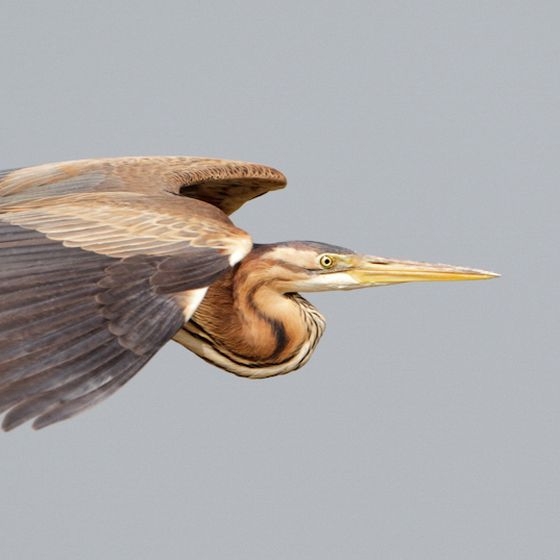Purple Heron

Introduction
With its warm buff head and neck, black cap, grey back and deep chestnut shoulder patch, the adult Purple Heron is a smart bird, but one that favours the dense vegetation, such as reedbeds, of shallow waterbodies.
Purple Heron is considered an occasional breeder, and one for which proving breeding can be difficult. Its European breeding population has been expanding since at least the 1940s, with colonisation of France and the Netherlands signposting this species as a potential colonist to Britain & Ireland.

Key Stats
Status and Trends
Conservation Status
Population Size
Population Change
Purple Heron is considered to be an occasional breeder in the UK, although there has only been one confirmed breeding attempt for this species, in Kent in 2010 [Eaton & the Rare Breeding Birds Panel 2024]. Around 25 migrant Purple Herons are seen annually during the summer and autumn months; the species is restricted to more southerly counties, with few recorded north of a line between the Mersey and the Humber [White & Kehoe 2024].
Distribution
Purple Herons are regularly recorded in Britain in the spring, typically arriving during periods of warm southerly winds between April and May and occasionally staying into the summer. During 2008–11
Occupied 10-km squares in UK
2007/08–10/11
or view it on Bird Atlas Mapstore.
2008–11
or view it on Bird Atlas Mapstore.
European Distribution Map
Distribution Change
from 1968–72 to 2008–11
or view it on Bird Atlas Mapstore.
Seasonality
Purple Herons are very scarce and usually only encountered in spring and summer.
Weekly pattern of occurrence
The graph shows when the species is present in the UK, with taller bars indicating a higher likelihood of encountering the species in appropriate regions and habitats.

Movement
Britain & Ireland movement
Foreign locations of birds ringed or recovered in Britain & Ireland
Dots show the foreign destinations of birds ringed in Britain & Ireland, and the origins of birds ringed overseas that were subsequently recaptured, resighted or found dead in Britain & Ireland. Dot colours indicate the time of year that the species was present at the location.
- Winter (Nov-Feb)
- Spring (Mar-Apr)
- Summer (May-Jul)
- Autumn (Aug-Oct)

European movements
EuroBirdPortal uses birdwatcher's records, such as those logged in BirdTrack to map the flows of birds as they arrive and depart Europe. See maps for this species here.
The Eurasian-African Migration Atlas shows movements of individual birds ringed or recovered in Europe. See maps for this species here.
Biology
Productivity and Nesting
Nesting timing
Egg measurements
Clutch Size
Survival and Longevity
Survival is shown as the proportion of birds surviving from one year to the next and is derived from bird ringing data. It can also be used to estimate how long birds typically live.
View number ringed each year in the Online Ringing Report.
Lifespan
Survival of adults
Survival of juveniles
Classification, names and codes
Classification and Codes
- Order: Pelecaniformes
- Family: Ardeidae
- Scientific name: Ardea purpurea
- Authority: Linnaeus, 1766
- BTO 2-letter code: UR
- BTO 5-letter code: PURHE
- Euring code number: 1240
Alternate species names
- Catalan: agró roig
- Czech: volavka cervená
- Danish: Purpurhejre
- Dutch: Purperreiger
- Estonian: purpurhaigur
- Finnish: ruskohaikara
- French: Héron pourpré
- German: Purpurreiher
- Hungarian: vörös gém
- Icelandic: Rauðhegri
- Irish: Corr Chorcra
- Italian: Airone rosso
- Latvian: rudais garnis
- Lithuanian: purpurinis garnys
- Norwegian: Purpurhegre
- Polish: czapla purpurowa
- Portuguese: garça-roxa / garça-vermelha
- Slovak: volavka purpurová
- Slovenian: rjava caplja
- Spanish: Garza imperial
- Swedish: purpurhäger
- Welsh: Crëyr Porffor
More Evidence
More evidence from Conservation Evidence.com
Partners
Citing BirdFacts
If you wish to cite particular content in this page (e.g. a specific value) it is best to use the original sources as linked in the page. For a more general citation of the whole page please use: BTO (20XX) BirdFacts Species: profiles of birds occurring in the United Kingdom. BTO, Thetford (www.bto.org/birdfacts, accessed on xx/xx/xxxx).

